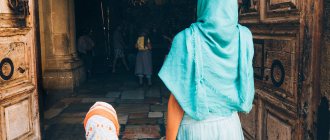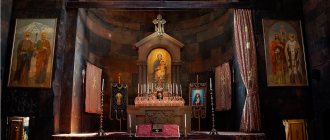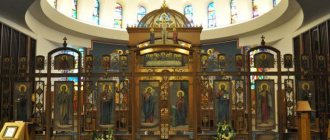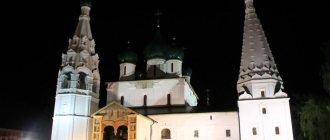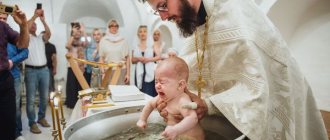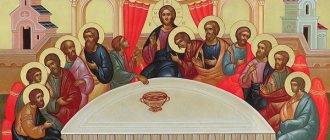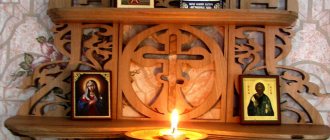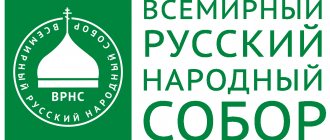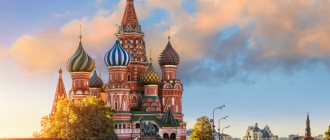History of appearance and development
In ancient Greek, iconostasis means an altar partition characterized by a more or less continuous structure. It stretches in the direction from the northern to the southern temple wall, thereby separating the altar from the main room. The iconostasis can contain from one to seven rows of Orthodox icons. The most common are five-tier options.
An iconostasis appeared with the purpose of enclosing the room with the altar of the main temple premises, a kind of separation between two principles - the earthly and the sacred divine. History says that the very first peculiar parapets appeared back in the fourth century.
When Christianity received legal status, many new believers began to come to the church, whose degree of churching remained insufficiently high. That is why, in order to prevent possible disrespect, it was decided to protect the altar and throne by installing a special barrier.
The original altar barriers in their appearance resembled fences of insignificant height or a row of columns. In its upper part, a transverse beam was often installed, which was called an architrave and was crowned with a cross. Since such a fence was not very high, the painting of the altar apses did not disappear from the view of the believers. While reading prayers, they could easily observe the altar room.
Later the cross was replaced with icons. The initial arrangement of the icons looked approximately this way - in the center there is an iconographic image of the Feast of the Annunciation of the Theotokos, on the sides - images of Christ the Savior and the Mother of God, and then, on either side of them - an icon of a saint revered in the area where the temple is located, and a temple icon (dedicated to the feast or the saint in whose honor this temple was named). A multi-tiered iconostasis of a classical type first appeared in the Russian Orthodox Church.
Initially, these structures were a copy of Byzantine models and consisted of two or three tiers.
According to surviving documentary information, the iconostasis, which had four tiers, dates back to the first half of the fifteenth century. It was installed in the Assumption Cathedral in the city of Vladimir, and its painting was carried out by the famous icon painters Andrei Rublev and Daniil Cherny, who were elevated to the ranks of saints. By the end of the fifteenth century, iconostases of this type and structure became widespread. The fifth row in the iconostasis first appeared in the second half of the sixteenth century. Since the seventh century, the number of tiers has increased by two more tiers.
Andrey Szegeda: How the iconostasis is arranged in an Orthodox church
The iconostasis received its main development precisely in the Russian Orthodox Church and this was associated with the peculiarities of national church construction. The temples of the Eastern (and for us, rather southern) patriarchates were mainly built of stone. Their interior decoration from the floor to the domes was painted with frescoes depicting the Lord, the Virgin Mary, saints and various theological and historical subjects.
In Russian churches the situation was different. Stone cathedrals were, so to speak, “piece goods” for cities or large monasteries. Most churches were built of wood and, accordingly, were not painted inside. Therefore, in such churches, instead of frescoes, new icons began to be added to the altar barrier, and from this it grew up several rows.
How the iconostasis appeared
In the Jerusalem Temple, the Holy of Holies was separated from the sanctuary by a huge curtain, which was torn in two after the Savior’s death on the cross, as a symbol of the end of the Old Testament and the entry of humanity into the New.
In the first three centuries of its existence, the New Testament Church was in a persecuted position and was forced to hide in the catacombs. The sacrament of the Eucharist was performed directly on the tombs of the martyrs in cubiculums (rooms) hastily adapted for the temple, where only their own people gathered. Under such conditions, there was neither the possibility nor any particular need to fence off the throne from those present.
The first mention of temples specially built for worship and of altar barriers or parapets separating the most sacred part of the temple from its main space dates back to the 4th century.
After the legalization of Christianity by the Holy Equal-to-the-Apostles Emperor Constantine the Great, a huge number of new believers came to the Church, whose level of churching was relatively low. Therefore, the throne and the altar needed to be protected from possible disrespect.
The first altar barriers looked either like a low fence, or like a row of columns, which were often topped with a transverse beam - an “architrave”. They were low and did not completely cover the painting of the altar apses, and also gave worshipers the opportunity to observe what was happening in the altar. A cross was usually placed on top of the architrave.
Bishop Eusebius Pamphilus mentions such barriers in his “Ecclesiastical History,” who, for example, reported the following about the Church of the Holy Sepulcher: “The semicircle of the apse was surrounded by as many columns as there were apostles.”
Quite soon, the cross on the architrave was replaced by a row of icons, and images of the Savior (to the right of those praying) and the Mother of God (to the left) began to be placed on the supporting columns on the sides of the royal doors, and after some time they began to supplement this row with icons of other saints and angels. Thus, the first one- and two-tier iconostases, common in the Eastern Churches, appeared.
Development of the iconostasis in Russia
The classic multi-tiered iconostasis first appeared and became widespread precisely in the Russian Orthodox Church, so that it was associated with the architectural features of Russian churches, which were already mentioned above.
The first churches built in Rus' copied Byzantine models. Their iconostases had 2-3 tiers.
It is not known exactly when exactly they began to grow, but documentary evidence of the appearance of the first four-tiered iconostasis dates back to the beginning of the 15th century. It was installed in the Assumption Cathedral of Vladimir, which was painted by the Reverends Andrei Rublev and Daniil Cherny. By the end of the century, such iconostases had spread everywhere.
In the second half of the 16th century, the fifth row appeared in the iconostasis for the first time. In the 17th century, a similar arrangement became classic for most Russian churches, and in some of them you can find iconostases in six or even seven rows. Further, the “number of storeys” of the iconostasis stops growing.
The sixth and seventh tiers were usually dedicated to the Passion of Christ and, accordingly, to the passion of the apostles (their martyrdom). These stories came to Russia from Ukraine, where they were quite popular.
Classic five-tier iconostasis
The five-tier iconostasis is a classic today. Its lowest tier is called “local”. To the right and left of the royal doors there are always icons of the Savior and the Virgin Mary, respectively. On the royal doors themselves there are images of the four evangelists and the plot of the Annunciation.
To the right of the icon of the Savior is usually placed the image of the saint or holiday to which the temple you are in is dedicated, and to the left of the image of the Mother of God is an icon of one of the saints most revered in this area.
Next come the southern (on the right hand of those praying) and northern (on the left) doors. They are usually painted with icons of the archangels Michael and Gabriel or the archdeacons Stephen and Lawrence (although other options are possible), and the rest of the local row is filled with several images of saints, also most revered in the region.
The second tier is called “festive”. Here the center of the composition is the icon of the “Last Supper” above the royal doors, to the left and right of which you can see scenes of the 12 most significant evangelical events from the point of view of the Church: the Ascension, the Presentation, the Nativity of the Virgin Mary, Her Presentation into the Temple, the Exaltation of the Cross of the Lord, the Entry of the Lord to Jerusalem, Transfiguration, etc.
The third tier is called “deisis” - from the Greek. "prayer". The central image of this series is the Lord Almighty, depicted in all his power and glory. He sits in golden robes on the royal throne against the background of a red diamond (the invisible world), a green oval (the spiritual world) and a red square with elongated edges (the earthly world), which together symbolize the entirety of the universe.
The figures of the Prophet, Forerunner and Baptist of the Lord John (right), the Most Holy Theotokos (left) and other saints are facing the Savior in positions of prayer. The figures of the saints are depicted half-turned towards the worshipers in order to show that during the service the saints stand with us before God, they are before him as prayer partners in our needs, for which we ask them.
The fourth row depicts the Old Testament prophets, and the fifth row depicts the forefathers who lived at the dawn of humanity. The icon of the Mother of God “The Sign” is placed in the row, and the icon of the Holy Trinity is placed in the row.
Iconostases in modern churches
The construction of the iconostasis, like other aspects of internal church life, is regulated by certain traditions. But this does not mean that all iconostases are exactly the same. When forming the iconostasis, they try to take into account the general architectural appearance of a particular temple.
If the temple premises were converted from some other structure and its ceiling is low and flat, then the iconostasis may well be made two-tiered or even single-tiered. If you want to show the faithful the beautiful painting of the altar apses, choose an iconostasis in the Byzantine style up to three rows in height. In other cases, they try to install a classic five-tier one.
The position and filling of the rows are also not strictly regulated. The “deisis” series may come after “local” and precede the “holiday” series. The central icon in the “festive” tier may not be the “Last Supper,” but the icon of the “Resurrection of Christ.” Instead of a festive row, in some churches you can see icons of the Passion of Christ.
Also, above the royal doors, a carved figure of a dove is often placed in rays of radiance, symbolizing the Holy Spirit, and the upper tier of the iconostasis is crowned with a cross or an image of the crucifixion.
Andrey Szegeda
Dear friends! I opened my own blog! If you are interested in reading my articles, please support me by subscribing and reposting!
You can applaud the author (at least 10 times)152
Structure and diagram of the classical iconostasis
The classic version of the temple iconostasis is five-row. Let's consider what characteristic features and significance each of the tiers of this structure has.
Bottom row
At the very bottom there is a row called “local”. Its main symbol is the Royal Doors, the doors of which are decorated with images of the Annunciation, as well as the four evangelists. There are also options in which only the Annunciation is present with full-length images of the Mother of God and Archangel Gabriel. On the right side there is a temple icon, which personifies the saint or religious holiday in honor of which the temple was consecrated. And on the left is an image in honor of the most revered local saint. On the left side of the double gates is a large icon of the Mother of God with a baby in her arms, and on the right is an icon of Christ the Savior. The symbol of the Holy Spirit is often placed above the Royal Doors - a white dove in shining rays.
Second row
The next row is known as the Deesis row. Another name is rank. Compared to the first, its structure is more complex, implying a larger number of small format icons. All his stories are dedicated to church prayer to Jesus Christ. Central image - Savior is in power. On the left side is the icon of the Intercessor. Mary, depicted in full growth, holds a scroll in one hand, and her gaze is directed to the left. On the right side is the icon of John the Baptist, who baptized Christ.
On the left and right sides of both icons are numerous images of prophets, God's main saints and archangels.
Third row
The third row is usually called festive or historical. It presents all the most important and significant events of Gospel history. In different churches, the third row device may contain a different number of icon paintings. The leading icon here is always the Nativity of the Blessed Virgin Mary. It is usually followed by:
- Introduction to the Temple;
- Nativity;
- Candlemas;
- Epiphany;
- Transfiguration;
- Entrance to Jerusalem;
- Crucifixion;
- Resurrection;
- Ascension;
- Descent of the Holy Spirit;
- Dormition.
Fourth row
The next tier of the Orthodox iconostasis is called prophetic. The building is dedicated to the Old Testament. In the center is the famous icon of Oranta, which depicts the praying Mother of God. The Most Pure Virgin with the Child Christ in her womb raises her hands to heaven in prayer.
Fifth row
The final tier in the classical iconostasis, characteristic of most Orthodox churches. It is called forefathers because it is dedicated to the most iconic figures of a more ancient era - Adam, Eve, Abel, Moses and others. In each temple, the choice of forefathers is arbitrary. The central plot of the fifth row is the Old Testament Trinity, which personifies the advice of the Holy Trinity on God’s self-sacrifice for the sake of atonement for the fall of mankind. At the very top of the iconostasis there is a crucifix.
How to pray in front of icons correctly
When standing in front of an icon, you should first of all remember that the prayer is offered to the Saint, the Mother of God or the Lord depicted on it, and not to the icon itself. Before starting the prayer, you should make the sign of the cross and, if desired, place a candle on a candlestick placed in front of the icon. After this, you should silently turn to the chosen saint with a request (you can perform the prayer itself either according to the text of the prayer book or in your own words - the main thing is that they are sincere). After finishing the prayer, you need to cross yourself again and bow.
In special cases, when urgent help is required or, conversely, when help in a serious matter has already been received, you can order a prayer service in front of the icon, which will be served by a priest with your participation.
What are there in modern churches and how are they located?
In modern churches, the structure of the iconostasis, along with other religious aspects, is subject to certain traditions.
The formation of the sequence of icons, as well as the number of tiers, in most cases depends on what the characteristic features of the temple architecture are in a particular case. In sacred buildings with low and flat ceilings, it is advisable to make low iconostases, with one or two tiers. To focus the attention of believers on the beauty and grandeur of the apse paintings, iconostases are installed in the altars, which consist of three tiers. In other situations, classic iconostases are built - that is, five-row ones. In sacred monasteries in Russia and Ukraine there are six- and seven-tiered iconostases. The icons in these two top rows are dedicated to the passions.
Icons of the Blessed Virgin Mary
In the Orthodox tradition there are a huge number of icons dedicated to the Mother of God. Most often in churches you can see such variants as:
- Vladimirskaya. People pray in front of this icon in case of illness (including mental illness), to soften evil hearts (in conflicts with ill-wishers), as well as in case of demonic influence.
- Kazanskaya. She is asked for help in various everyday matters, with financial problems, as well as difficulties in her personal life (for example, when it is not possible to start a family).
- Quick to Hear. It is especially often used in situations where a person needs help as soon as possible - with serious life-threatening illnesses, blindness, paralysis, and serious mental illnesses. In addition, they pray to her for the birth of new children and for the release of people who find themselves in prison.
- Burning bush. She is considered the patroness of pilots, military personnel, firefighters and doctors. Before her they ask the Mother of God to protect the house and all property from fires, and also pray for peace of mind and healing of ailments.
- Joy to all who mourn. Brings help and consolation in various everyday sorrows, helps solve financial problems, protects people engaged in trade on long journeys.
- Iverskaya. Before her, prayers are said for the healing of the sick and help in physical danger (for example, when attacked by enemies).
- Three-handed. Before her they ask for help with illnesses (especially with diseases of the hands), with various sorrows and problems.
- Inexhaustible Chalice. The most famous image in front of which they pray to the Mother of God for the healing of loved ones from the ailments of drug addiction and drunkenness.
What icons should be in the temple
There are no canons strictly regulating the list of icons located in the main part of the temple (not in the iconostasis).
Of course, in addition to the icons of the Savior, there must be an image of the Mother of God. In practice, there are usually several icons of the Mother of God in a church. The most revered are Kazan, Vladimir, Iverskaya, Vsetsaritsa, Feodorovskaya, “Sign”, “Tenderness”. People joyfully pray at the icons, the very name of which seems to call to turn to the Most Pure One for help: “Healer”, “Helper in Childbirth”, “Unexpected Joy”, “Joy to All Who Sorrow”, “Quench My Sorrows”, etc.
There is hardly a Russian Orthodox church without an icon of St. Nicholas the Wonderworker. Parishioners joyfully pray at the icons of the Great Martyrs Panteleimon and George, the Archangels (we especially venerate the Archangel Michael), St. Spyridon of Trimifunt, St. Sergius of Radonezh and Seraphim of Sarov, Blessed Xenia of St. Petersburg, Blessed Princes Peter and Fevronia, and Alexander Nevsky. Of the recently glorified saints of God, Blessed Matrona of Moscow, Hiero-Confessor Luke (Voino-Yasenetsky), and the Royal Passion-Bearers enjoy ardent veneration.
If there is space, it is good to place in the temple images of saints, whose names many of our contemporaries bear: people will be pleased to light a candle with a prayer to their heavenly patrons. Equal to the Apostles Cyril and Methodius, Nina, Mary Magdalene, Prince Vladimir and Princess Olga, Tsars Constantine and Helena, martyrs Tatiana, Marina, Anastasia, Julia, Galina, passion-bearers Boris and Gleb, Igor Chernigovsky, righteous Joachim and Anna, Artemy Verkolsky - in honor Many of the parishioners were named these saints of God in the sacrament of Baptism. Of course, no matter how spacious the temple, the icons of all the saints revered by believers will not fit on its walls. Therefore, it makes sense to purchase an icon of All Saints for the temple - you can pray in front of it to any of God’s saints.
It is highly desirable that there be a crucifix
, with the upcoming (Our Lady and the Apostle John the Theologian) or without them.
A canon
is usually placed in front of it (another option is “
kanun
”) - a candlestick on which candles are placed with a prayer for the repose of the deceased. However, in some churches there is an ordinary candlestick near the crucifix - people simply pray here to the Savior, not only for the dead, but also for the living. The canon, as a rule, is itself equipped with a small crucifix, so whether to place it at the temple cross or not is up to the abbot to decide.
If a canon in a church stands near the Crucifixion, it makes sense to place another image of the Savior in a place accessible to parishioners (it doesn’t matter: shoulder-length or full-length, “Savior Not Made by Hands,” “Resurrection of Christ,” “Transfiguration,” “Savior in a White Tunic,” etc.). etc.) so that believers can pray, venerate, light candles with a prayer to the Lord. Otherwise, a certain imbalance may arise when parishioners get used to resorting to the saints and the Mother of God for their needs, and forget about praying to the Savior. Of course, it would be desirable for the church to also have an icon of the Holy Trinity.
When purchasing icons for the temple, let’s not forget about analogue images
. These are small icons that are placed on the central lectern of the church, selected depending on what day of the church year we are living today. It makes sense to buy a set of analogue icons. It includes menaions - images of the councils of saints by month. Also needed is an icon of the Resurrection of Christ, which is taken out for veneration on every Sunday, icons of the twelve feasts and the most revered saints, the most revered images of the Mother of God (Vladimir, Kazan, etc.). Since a large number of parishioners are attached to analogue icons, you should immediately purchase a case with glass that will protect the images - otherwise they will have to be replaced very soon.
Techniques for making icons
The classic option is written icons
.
There are two main techniques for painting icons: with tempera and oil paints. As a rule, icons are painted in tempera in the canonical
and sometimes
in the academic
style, and in oil –
in the academic and pictorial style
. Painted icons are quite expensive, like any handmade item.
A good solution for a poor church are icons made using lithography technique and enclosed in a wooden icon case. They can be decorated using the foiling method, which is used to create gold or silver details and embossed patterns.
What to pay attention to
If the church interior is created from scratch, you should make sure that all the icons on the walls of the temple or in standing icon cases are made in the same style
, combined with each other and with the images on the iconostasis. So that icons of the same size and shape are located next to each other and symmetrically to each other. Then, even with rather modest decoration, the church interior will be harmonious.
It is worth paying attention not only to the shape and size of the icons, but also to their artistic style. Of course, icons made in the Russian and Greek traditions, in canonical and academic styles, can be placed in one church. But if you have a lot of choice, it's probably worth maintaining some uniformity.
Believers love to venerate icons. Candles lit in front of them tend to smoke. To protect icons, you should place them in glass cases - this is simpler and ultimately cheaper than having to restore or even replace the images in a few years, or even months.
History, technique and styles of icon painting. Brief excursion
Icon painting, one of the main church arts, has developed over two millennia.
The first icon is the image of the Savior Not Made by Hands
. According to legend, he appeared on the board that the Savior applied to His face. The image of the Savior Not Made by Hands was kept in Byzantium, in Constantinople. There is a version that this is the famous Shroud of Turin - the canvas in which the body of Christ was wrapped during burial, and on which His image was displayed at the Resurrection. Since the Shroud was kept folded, people saw only the face. Be that as it may, the very first image of the Lord was revealed to humanity by the will of God, in a miraculous way.
The first icons of the Mother of God
, according to legend, were written by the Evangelist Luke, who personally communicated with the Most Pure One. The most famous of these icons for Russian people is Vladimir. And, for example, on the Philermos icon, also painted by St. Luke, the Virgin Mary is depicted in old age.
According to ancient tradition, icons are written on a wooden board.
, covered with a special primer. In ancient times, craftsmen worked with encaustic paints, that is, paints diluted with specially prepared wax. This is how, in particular, the image of Christ Pantocrator, located in the monastery of St. Catherine on Mount Sinai, was painted. It is believed that this icon most closely matches what Christ actually looked like. Some asymmetricalness of the face indicates that the icon painter used the Shroud with the posthumous image of the Lord as a model and saw the wounds that were inflicted on the Savior before his execution.
In Rus' in the old days they painted with tempera paints. This technique is still used by icon painters today. Such paints are made on the basis of natural minerals, sometimes plant pigments are used, less often - animal (obtained from insects) pigments. Egg yolk is used as a binder. They used the same colors to paint in the Middle Ages, both in Byzantium and Europe. Tempera icons are often decorated with gilding, for which natural gold leaf is used.
Tempera icon
written on a board on which a special primer has been applied, which gives the surface a special smoothness and hardness.
A fabric is glued onto the tree - pavolok
gesso
is created on top of it - a soil made from a mixture of chalk with glue (usually made from fish bones) and some other components.
Previously, icon painters covered icons with drying oil - a varnish made from vegetable oil boiled until thick. Drying oil tends to darken over time, so the image on old icons practically disappeared over the years, and they were renewed - in fact, a new image was painted on top of the old one. At the beginning of the twentieth century, scientists invented a technology for opening ancient icons - removing old drying oil. Thanks to this, masterpieces of ancient Russian art were revealed to the world, such as “The Trinity” by St. Andrey Rublev. Nowadays, icon painters, as a rule, use varnishes that do not darken over the years.

